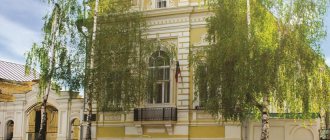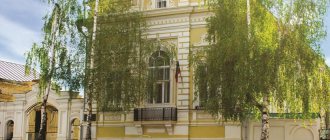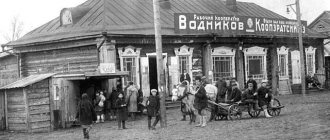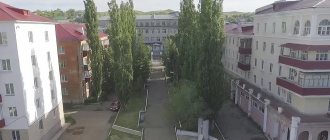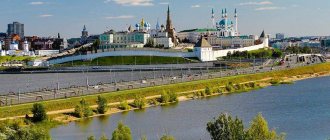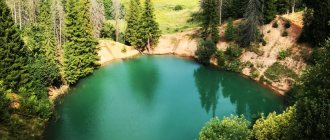Chistopol is a popular tourist town located on the left bank of the Kama River. The settlement is located 140 kilometers from Kazan. The compact merchant town is filled with a particularly atmospheric atmosphere, as its historical buildings have been preserved in excellent condition. Ancient mansions, small houses with carvings, and Orthodox churches are symbols of the city. The name of the city comes from the word “Clean Field”. The fact is that archaeologists discovered ancient Bulgar settlements on these lands.
There is information about the village in ancient chronicles of the 17th and 18th centuries. Serfs settled en masse in this area. Mostly these were people from among the fugitives. Subsequently, schismatics arrived in the village and were sent here from different regions. It was planned to organize a free settlement of co-religionists on the Kama coast. The very first residents gave the name to their village “Clean Field” because of the abundance of empty spaces and forests on the outskirts. The population lived by hunting and fishing. Agriculture also flourished.
General information and economics
Chistopol is a city of regional significance, the center of the Chistopol district of the Republic of Tatarstan. It is located 135 km southeast of Kazan. The city is located on the left bank of the river. Kama, in the area of the Kuibyshev reservoir. The nearest major railway runs 125 km to the north (Nurlat station).
The city's population is not very large: in Russia the city ranks 272nd in terms of the number of inhabitants. At the moment, 61 thousand people are registered in it. The sights of Chistopol, described in this article, are an important component of life.
The city's economy is connected with the activities of industrial enterprises. There are maintenance plants and food industry enterprises (meat, fish, dairy, bakery). A large number of plants and factories determine the employment structure of the local population: most citizens work in production.
Links[edit]
Notes[edit]
- ^ abcdefg Order No. 01-02/9
- ^ abc Federal State Statistics Service (2011). “All-Russian Population Census 2010. Volume 1" [All-Russian Population Census 2010, vol. 1]. All-Russian Population Census 2010 [All-Russian Population Census 2010]
. Federal State Statistics Service. - "26. The size of the permanent population of the Russian Federation by municipalities as of January 1, 2022". Federal State Statistics Service. Retrieved January 23, 2022.
- ^ abcde Law No. 44-ZRT
- "On the Calculation of Time". Official Internet portal of legal information
. June 3, 2011. Retrieved January 19, 2022. - Post office. Information and computing center of OASU RPO. ( Post office
).
Search for postal service objects ( postal Search for objects
) (in Russian) - ↑
Federal State Statistics Service of Russia (May 21, 2004).
“The population of Russia, the constituent entities of the Russian Federation as part of federal districts, urban settlements, urban settlements, settlements, settlements of 3 thousand or more people” [Population of Russia, its federal districts, federal districts, districts, urban settlements, rural settlements - administrative centers and rural settlements with a population of more than 3000] (XLS). All-Russian Population Census of 2002 [All-Russian Population Census of 2002]
. - “All-Union Population Census of 1989. The current population of union and autonomous republics, autonomous regions and districts, territories, negative phenomena, urban settlements and rural district centers” [All-Union Population Census of 1989: current population of union and autonomous republics, Autonomous regions and districts , territories, regions, districts, towns and villages performing the functions of district administrative centers. All-Union Population Census of 1989 [All-Union Population Census of 1989]
.
Institute of Demography of the National Research University: Higher School of Economics [Institute of Demography of the National Research University: Higher School of Economics]. 1989 - via Demoscope Weekly
. - “All-Union Population Census of 1979. National composition of the population by regions of Russia” [All-Union Population Census of 1979. Ethnic composition of the population by regions of Russia] (XLS). All-Union Population Census of 1979 [All-Union Population Census of 1979]
.
1979 - via Demoscope Weekly
(website of the Institute of Demography of the State University - Higher School of Economics. - https://www.idelreal.org/a/28510391.html
Climatic conditions
The climate of the city is moderately cold, continental, typical of the eastern part of the European Plain. The average annual temperature is about + 4 degrees, the annual precipitation is about 550 mm. The minimum amount of precipitation occurs in March (26 mm), the maximum in July (72 mm). The coldest month is January (-13°C), the warmest month is July (up to +20°C).
Climatic and soil conditions are favorable for the cultivation of many crops, with the exception of heat-loving ones.
City `s history
Initially, the city was a village called Chistoe Pole. It was first described in chronicles at the turn of the 17th and 18th centuries. This name is due to the fact that the original settlement, organized by fugitive peasants, was burned and then rebuilt. Since 1781, it received the status of a city, which was named Chistopolye, later renamed Chistopol.
At the turn of the 19th and 20th centuries, Chistopol was a regional center of grain trade. In the 20th century, industrial production actively developed. During the Great Patriotic War, the city became the place of residence for a number of famous writers hiding from the war: Anna Akhmatova, Arseny Tarkovsky, Boris Pasternak, Nikolai Aseev. The house where Pasternak lived subsequently acquired the status of the Writer’s Memorial Museum.
How to get to Chistopol
It’s easy to get from Kazan to Chistopol by bus: the schedule is very convenient, there are many flights, so the trip will be absolutely comfortable.
If you are driving a personal car, keep in mind that you can see along the way
- Laishevo (Kama Sea and Semruk ),
- Magpie Mountains (Kama Bridge).
In addition to what has been said, there are a lot of picturesque villages and simply beautiful places on the Kama River, where you can taxi along the road.
TOURS to Kazan
What else to read about Tatarstan and Kazan
Route around Tatarstan Kazan in 1 day Kazan in 3 days Kazan City Bus Where to eat deliciously in Kazan Souvenirs from Kazan Where to stay in Kazan Public transport Kazan Elabuga Chistopol Sviyazhsk Bolgar Raifa Monastery Laishevo and the Kama Sea Semruk Verkhniy Uslon and Makaryevsky Monastery
Cathedrals
One of the most popular sites in Chistopol is St. Nicholas Cathedral. It was built in 1838. The building was deteriorating quite quickly, so a major restoration was carried out in 1901. St. Nicholas Cathedral is considered one of the most valuable historical sites in Tatarstan. It is made in white and blue colors, in the style of classicism. Until 1990, it was used as a warehouse for construction materials, which was typical of Soviet times. After 1990, it was used for its intended purpose, and work was carried out to restore the building. The cathedral is located at: st. Karl Marx, 2.
The Church of the Icon of the Mother of God was built in the 19th century. It is a small tower building with a cemetery around it. During the Soviet years, the church was often closed to visitors, and during the Great Patriotic War it was used as a prison. The snow-white church building is one of the favorite places of the townspeople.
The Nur Mosque is considered one of the most ancient in Tatarstan. It is made of wood in the traditional local style and lined with pine trees. The mosque is always open to parishioners and is also a historical monument.
Beautiful buildings
The House-Museum of Boris Pasternak is one of the most interesting attractions in Chistopol and is a small mansion that has well preserved its original appearance and interior furnishings. The writer lived here during the Great Patriotic War with his family. The house was converted into a museum by decision of local authorities in the year of the writer’s centenary.
In the museum you can get acquainted with Pasternak's things, objects, documents, photographs, and personal notes. Among them are books, a flask, a snuff box, and family photos. The second floor of the building was allocated for the museum. The museum is located at: st. Lenina, 81. Tens of thousands of people visit it every year.
Some of the sights of Chistopol, photos of which are presented in the article, are known precisely because of their unique architecture. This is the house of the merchant Melnikov. The building cannot be called ancient - it was built relatively recently. Nevertheless, it is considered the unofficial calling card of Chistopol.
This structure is painted white with gray trim and has a spire on its roof. The history of the building is connected with the success of the local merchant Melnik. With the money raised, it was decided to erect a building that was unusual for those times. The original design and subtlety of decoration to this day distinguish it from other houses in Chistopol. Now this house is considered a public building; the inside is not of much interest to tourists: it houses a library and an art hall.
The attractions of Chistopol include the city museum. It is one of the most popular museums in Tatarstan. It is located in a merchant's house. Here you can see paintings by local and foreign artists, as well as ancient relics discovered in local excavations: ancient beads, knives, horseshoes, precious stones, dishes, etc. The museum includes 5 spacious and well-lit halls.
Scenic Spots
The remnant of the ancient settlement is the site of Dzhuketau. The attraction is located in the suburbs of Chistopol, on the banks of the Kama River. The settlement was founded back in the 10th century AD and was a military, political, commercial and cultural center of regional importance. Initially, the city looked like a fortress, after which it became a real principality. After 200 years, presumably in 1236, it was severely damaged by military raids, and after another 200 years, its inhabitants abandoned it. The remains of ancient gates, working wells, foundations of houses - this is all that remains of the ancient settlement.
In addition to the ruins, tourists can get acquainted with the nature of the Lower Kama region. Skaryatinsky Garden is not only a place of recreation for citizens, but also a historical landmark of Chistopol. It is located in the central part of the city and is abundantly landscaped. The year of foundation is 1867. In 2013, the garden acquired a more modern appearance, a cafe, carousels, and playgrounds for children appeared. From the point of view of historical value, this is a minus, but in its modernized form it attracts many visitors, since there are more recreational opportunities and amenities.
What else to visit
- Melnikov House , where an art salon and a children's library are located.
- Skaryatinsky Garden , which was founded in 1867 with funds from local merchants.
- Not far from Chistopol, the remains of the Golden Horde city of Dzhuketau (X-XV centuries) have been preserved.
If you have not yet chosen where you will live and want to save money when booking, we recommend using the RoomGuru service. Firstly, it contains hotels, apartments and guest houses from many different booking systems, so you won’t miss out on a worthwhile option. Secondly, you can immediately compare prices for one place in different services and book where it is cheaper (this is not always Booking!).
